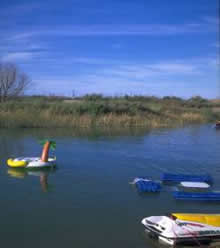Recreational Water Safety
 Missouri is rich in water. With that wealth comes a multitude of water recreation activities for Missouri citizens and visitors to take advantage. From multi-million-gallon water parks with wave pools and slides, to scenic natural rivers and everything in between, there is a water recreation outlet for everyone who lives in or visits Missouri. Though innumerable hours of fun can be had on the various water recreation areas in Missouri, you should be aware that hazards also lurk in the water.
Missouri is rich in water. With that wealth comes a multitude of water recreation activities for Missouri citizens and visitors to take advantage. From multi-million-gallon water parks with wave pools and slides, to scenic natural rivers and everything in between, there is a water recreation outlet for everyone who lives in or visits Missouri. Though innumerable hours of fun can be had on the various water recreation areas in Missouri, you should be aware that hazards also lurk in the water.
Recreational water sites can be classified into two general areas: natural areas such as streams, lakes and reservoirs and controlled areas such as public and semipublic pools, spas and water parks. Each has their own safety concerns.
Many local health departments do have active recreational water safety programs including regular inspections and sampling of controlled pools/spas and natural bathing beaches and subsequent bather safety recommendations based on their findings. The Department of Health and Senior Services takes an active role in commercial lodging facility pools, and via contracts with local health departments, we ensure these pools are meeting a minimum safety and sanitary standard prior to allowing a lodging facility annual licensure.
Natural water areas
Missouri is fortunate to have a vast variety and number of beautiful natural bodies of water throughout the state. Natural, uncontrolled bodies of water such as streams, lakes and ponds, all have naturally occurring bacteria at certain levels and some may contain pollutants. However, if you practice healthy swimming habits, you can enjoy these bodies of water and reduce the potential for becoming ill. In addition to visible pollution, such as debris or trash, water can contain contaminants that cannot be seen. This may occur from natural events such as runoff after a storm and waste from wildlife, waterfowl, pets and farm animals. Other events that may contribute to water pollution include sewage sources such as bypasses from sewage pump stations, storm water sewer overflows, sewage spills, seepage from failing septic systems and boat waste discharges.
Reduce the risk of waterborne illnesses when swimming in natural bodies of water
What is waterborne illness?
Bacteria, viruses and parasites in water may cause a “waterborne illness.” When people are exposed to too many of these microorganisms while enjoying activities that involve body contact with recreational water, they can become ill. Because the number of potential pathogens is too vast to monitor individually, indicator organisms, such as Enterococci and E. coli, are monitored and used to assess recreational water quality.
What are the symptoms of waterborne illness?
Symptoms of waterborne illnesses are varied but may include abdominal cramps, diarrhea, vomiting, fever, headache, or infections of the eyes, ears or skin. Symptoms seldom appear immediately after exposure. Most symptoms will occur within 1-3 days, but some illnesses may take as long as 4 weeks after swimming.
What should I do if I become ill after swimming?
Symptoms of waterborne illness may appear within a day or up to 4 weeks after swimming. If you become ill after swimming, check with your doctor first. After getting appropriate medical attention, please report waterborne illnesses to your local health department.
How do I find out if a swimming beach is under advisory?
Look for posted signs or flyers on bulletin boards at individual beaches. Follow these notifications and enjoy the area. In addition, visit the Missouri State Parks website for information concerning Missouri State Park public beach advisories. Missouri State Parks performs weekly water quality testing at their public beaches and subsequent beach status updates are reported on the Missouri State Parks Beach Status webpage.
Many waterborne illnesses can be prevented by taking a few simple precautions
Choose Swimming Areas Carefully
- Pay attention to signage and avoid swimming in waters that are closed or under advisory because of pollution or other risks.
- Avoid swimming or playing in water that is stagnant or smells unpleasant, is unusually cloudy, has unusual color, or has excessive algae growth.
- Avoid swimming or playing in natural waters immediately after a heavy rain event.
- Do not swim or play in waters near sewer pipes, discharge pipes, or storm drain outlets.
- Do not swim in water that is also frequented by livestock or other land animals.
- Do not swim in areas containing a large number of dead fish or other dead animals in or near the water.
Take Simple Precautions
- Avoid getting the water in your mouth and do not drink or swallow water from lakes, streams, ponds or other swimming areas.
- Reduce the risk of water going up your nose by holding your nose shut or using nose clips when taking part in water-related activities at lakes, streams, ponds or other swimming areas.
- Never swim with open sores. Promptly tend to any wounds, cuts or abrasions you get while in or near the water: thoroughly wash the wound with clean water and soap, and seek a doctor’s care if redness or swelling develops around the wound.
- Shower with soap and a clean source of water as soon as possible after swimming or playing in the natural water body.
- If you have a weakened immune system, check with your doctor before swimming.
- Wash your hands before eating or drinking or use hand sanitizer if clean water is not available.
